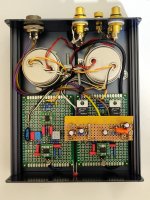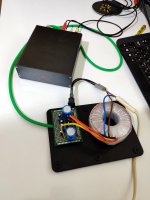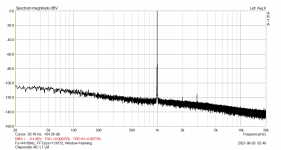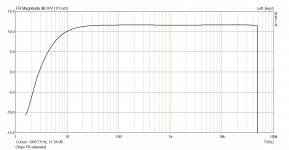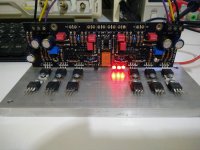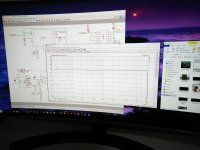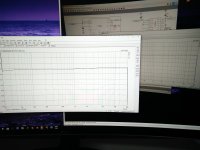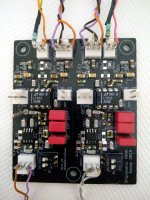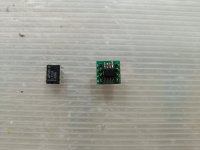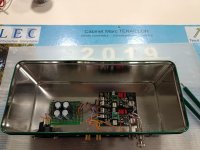I didn't have the heart to scrap the agricultural build grade prototype boards. I gave them a little house. Never too late.
What's Another Year! Johnny Logan used to sing.
Kept the OPA1656 for U2 U3. Added close proximity LT regs at +- 17Vout. Don't wonder why wasting TO-220 1.5A chips on a 2.2W mains consumption phono job. I simply used them because I had them.
But the Tx proved too high for the 20V max input spec positive LT reg. What a wimp! Here we go, yet another perfboard.
LM317-337 pre-regs shifting from +-23V Raw DC down to +-18.5V. Its the Chipomatic so everything had to be chips.
What's Another Year! Johnny Logan used to sing.
Kept the OPA1656 for U2 U3. Added close proximity LT regs at +- 17Vout. Don't wonder why wasting TO-220 1.5A chips on a 2.2W mains consumption phono job. I simply used them because I had them.
But the Tx proved too high for the 20V max input spec positive LT reg. What a wimp! Here we go, yet another perfboard.
LM317-337 pre-regs shifting from +-23V Raw DC down to +-18.5V. Its the Chipomatic so everything had to be chips.
Attachments
Speaker system is ATC SCM20SL & SVS SB-1000-Pro subwoofer (out of picture in a corner). Posing on the ATC is of course Chipomatic.Want to know more about every single unit
Turntable is Bauer Audio DPS3 with the Bauer unipivot tonearm, cartridge is Dynavector DRT XV-1t. Below, a DBX tape monitor multi input router. Then a Nakamichi RX-505, Valve Itch Phono, Alpage AL-80, Revox B215. Phono's PSU rests on the floor.
Next rack top to bottom, Nakamichi CR-7, Magnum Dynalab FM tuner with triode output stage, Bryston BCD-3 CD Player, Benchmark DAC3 HGC.
DCG3 shotgun balanced build is controlling traffic, Bryston 4B Cubed power amp does the heavy lifting, L-Adapter PSU on the floor powers an out of sight RPI4 running Volumio. Controlled by phone app for NAS files & streaming via USB to that DAC3.
There are more decks, amps, tuners, in his collection not shown here. Luxman, Harman Kardon, Nak, Akai, Sony, etc. Also a UFSP phono, a regular DCG3, and a Benchmark AHB2 power amp.
FM signal comes from a roof antenna for stronger and multipath free reception. All decks are mechanically and electronically restored, re-calibrated, recapped.
Two DCG3 boards creating a balanced XLR build. Like a double barreled shotgun. Twin side by side cables are also named shotgun sometimes. Six plus six Mosfets assembled on a cooling plate ready to accept the other dual phase assigned board as shown in my archived picture of that preamp unit.
Attachments
Hi Salas,
This thread died a few months ago, but I’m wondering what you thought comparing the Sowter vs Jensen transformers?
I have the Sowters, but always wondered about the Jensens.
I have no complaints about the Sowters, personally. Always prefer them to running a headamp or increased gain at the input stage.
Regards,
John
This thread died a few months ago, but I’m wondering what you thought comparing the Sowter vs Jensen transformers?
I have the Sowters, but always wondered about the Jensens.
I have no complaints about the Sowters, personally. Always prefer them to running a headamp or increased gain at the input stage.
Regards,
John
Decided to add this to the thread as it goes back to some of the early comments made by Scott:
I was reading the application note AN-245 "Instrumentation Amplifiers Solve Unusual Design Problems" by Scott Wurcer and Walt Jung, 1983.
https://www.analog.com/media/en/technical-documentation/application-notes/5866763300941an245.pdf
In it they give an example of an INAMP phono preamplifier with 100dB CMRR, using the AD624
https://www.analog.com/media/en/technical-documentation/data-sheets/AD624.pdf
I was reading the application note AN-245 "Instrumentation Amplifiers Solve Unusual Design Problems" by Scott Wurcer and Walt Jung, 1983.
https://www.analog.com/media/en/technical-documentation/application-notes/5866763300941an245.pdf
In it they give an example of an INAMP phono preamplifier with 100dB CMRR, using the AD624
https://www.analog.com/media/en/technical-documentation/data-sheets/AD624.pdf
Resurecting an old thread as I feel it fully deserves it!
For various reasons beyond my control I took ages to finish my Chipomatic, but it is nearly done and I don’t regret it a bit as it right now plays in my main system and will stay there as sole RIAA amp.
Before going into some details, I wish to express my thanks to the unbelievable Nick aka Salas. Nick sent me kindly the board, and provided endless support and kindness. When I was stuck due to my inexperience (measuring high gain RIAA amps isn’t that easy if you aren’t used to it, they DO need to be boxed and are REALLY FAR more sensitive than say line preamps or amps), believing I had messed up, he was kind enough to have look at my Chipo, even to clean it, to measure it and to send it back to me with reassuring words and some advices on how to test and how to progress. GREAT THANKS and big credits to him!
Now to the Chipo. This unit has a hard time as it has to replace my beloved H-K full discrete RIAA board with massive PS. Since ages I wanted to try a simple non expensive but efficient RIAA preamp built around the latest integrated chips I used to hate so much… and that impressed me so much recently. It had to be a very qualitative RIAA amp though. I had put everything on the paper in details, but would have failed for sure (first try for such a sensitive device), whereas at that point the Chipomatic appeared on the scene. It had most of the ideas I wanted to test on board, with a passive equalization etc. And Nick was soooo kind to send me a board he had left!
I used that board as it came, it was a prototype which only needed a minor correction at 2 locations, but was great in quality. It had to as it is mainly SMD, including quite tiny LDOs. I never soldered such small legs, practiced a bit… and I succeeded, so no reason you wouldn’t!
The board was very clear and top quality. Apart from the mentioned small correction, I used my notes for my project and decided to go for a somewhat higher MM gain, boosting a tad the second stage (no real lost in terms of overload margin or noise), more in line with what is done today (and as measured without significant downsides).
I built my own PS, in a sperate box with a 5m ombilical. PS box has tranny and diodes to have 2 rectifiers, filtering is CRCC. CR are in the PS box, ombilical provides some extra R, CC are next to the Chipo. Let’s not forget that this is just the basic PS and the Chipo includes great LDOs to regulate the positive and negative voltages, not to mention that the OPA chips it uses also have great PS noise rejection.
Long story short, I had some doubts and not the adequate equipment to test the Chipo before plugging it. The Chipo was measured by Nick and displayed IMHO outstanding results. I attached 2 shots, courtesy of Nick, and one can see the Chipo out of the box has a corrected frequency response within +- 0.3dB. One can also see there is an ever so slight imbalance (normal) and a slightly raising tendency which is often not preferred, so Nick adviced (although absolutely not mandatory as great out of the box) I could play with the filtetring caps to tweak that a bit. More later.
Oh, and at this stage I didn’t use a coax cable inside the Chipo box. More on that later, I need to decide on that LOL
For various reasons beyond my control I took ages to finish my Chipomatic, but it is nearly done and I don’t regret it a bit as it right now plays in my main system and will stay there as sole RIAA amp.
Before going into some details, I wish to express my thanks to the unbelievable Nick aka Salas. Nick sent me kindly the board, and provided endless support and kindness. When I was stuck due to my inexperience (measuring high gain RIAA amps isn’t that easy if you aren’t used to it, they DO need to be boxed and are REALLY FAR more sensitive than say line preamps or amps), believing I had messed up, he was kind enough to have look at my Chipo, even to clean it, to measure it and to send it back to me with reassuring words and some advices on how to test and how to progress. GREAT THANKS and big credits to him!
Now to the Chipo. This unit has a hard time as it has to replace my beloved H-K full discrete RIAA board with massive PS. Since ages I wanted to try a simple non expensive but efficient RIAA preamp built around the latest integrated chips I used to hate so much… and that impressed me so much recently. It had to be a very qualitative RIAA amp though. I had put everything on the paper in details, but would have failed for sure (first try for such a sensitive device), whereas at that point the Chipomatic appeared on the scene. It had most of the ideas I wanted to test on board, with a passive equalization etc. And Nick was soooo kind to send me a board he had left!
I used that board as it came, it was a prototype which only needed a minor correction at 2 locations, but was great in quality. It had to as it is mainly SMD, including quite tiny LDOs. I never soldered such small legs, practiced a bit… and I succeeded, so no reason you wouldn’t!
The board was very clear and top quality. Apart from the mentioned small correction, I used my notes for my project and decided to go for a somewhat higher MM gain, boosting a tad the second stage (no real lost in terms of overload margin or noise), more in line with what is done today (and as measured without significant downsides).
I built my own PS, in a sperate box with a 5m ombilical. PS box has tranny and diodes to have 2 rectifiers, filtering is CRCC. CR are in the PS box, ombilical provides some extra R, CC are next to the Chipo. Let’s not forget that this is just the basic PS and the Chipo includes great LDOs to regulate the positive and negative voltages, not to mention that the OPA chips it uses also have great PS noise rejection.
Long story short, I had some doubts and not the adequate equipment to test the Chipo before plugging it. The Chipo was measured by Nick and displayed IMHO outstanding results. I attached 2 shots, courtesy of Nick, and one can see the Chipo out of the box has a corrected frequency response within +- 0.3dB. One can also see there is an ever so slight imbalance (normal) and a slightly raising tendency which is often not preferred, so Nick adviced (although absolutely not mandatory as great out of the box) I could play with the filtetring caps to tweak that a bit. More later.
Oh, and at this stage I didn’t use a coax cable inside the Chipo box. More on that later, I need to decide on that LOL
Attachments
I tried the Chipo with various FET op amps, as required, and preferred by far (again…) OPA 1656. The difference was massive vs the dummy LT AOP I used – dummy as in case I messed something up I wouldn’t want one OPA from my ‘OPA flavour box’ LOL). It sounded OK on the LT (see pix), but really shone with the OPA1656.
I use the Chipo with my beloved Goldring 1042, an excellent match to my Rega arm, so what follows applies to MM only – I didn’t stuff nor tried MC. The Chipo with OPA1656 is extremely musical and enjoyable, while also incredibly revealing. It is very balanced in terms of tonality, reaches from lowest bass to highest frequency with fluidity and drive, it is very airy and in fact it displayed no downside whatsoever, did nothing wrong or mitigated, on the contrary.
It impressed me in the bass extension, in the treble extension, and even more in the soundstage… all traits of great units. Soundstage is 3D and has great extension in all 3 dimensions, while not losing on the precision of the instruments and voices, nor on their location and room / size. Details extracted from discs are abundant, while backnoise is reduced and pops remain “dimensionless”, desesperately glued to LS drivers in a single plane, so you enjoy real music even more with non perfect LPs. I didn’t expect that either, great plus.
Dynamic and drive are great, body / flesh always there, sounding neutral to full but never blurred or too euphonic. Everything just sounds right, it is difficult to review it as it is so enjoyable and never boring nor fatiguing. I didn’t think one could achieve that without discrete parts, getting carried away that easily when doing critic listening tests.
Following Nick’s advice, I tweaked the filter. Not that it needed it, but I was curious to try that. TBH, given the additional values in pF range, I didn’t expect to hear any difference at all, so I was quite biased on “OK, give it a quick try and be done, do you really expect to hear THAT?”.
However, in case it would work or need further tweaking, I purchased several film caps to be able to play and very finely tune, having a set of various values for both channels. I didn’t exactly follow Nick’s advice on the choice of caps (SMD caps - and there are some qualitative ones - would have indeed fitted nicely between the legs of the existing through hole C2s caps). I went for (comparatively) large though hole caps with legs, but PP ones as I had good experience with decoupling MKS with MKP soundwise in the past. The caps fitted nicely under the board directly on the existing big cap legs – I made sure the additional caps legs were kept shortest, while not touching anything else underboard. Close to the mouseswitch is nice. I didn’t do any pix as I wanted to do it in the quickest manner to test the sonic difference without relying too much on auditive memory. Once the Chipo gets its definitive box I could take some pix if of any help to someone.
So I went for additional Wima PPs (series FKP 2), a 68pF for the right channel, a 150pF for the left channel, to get the response even better. Didn’t expect anything but… it did make a change, and not as subtle as expected although of course not massive. And not just where one would expect it. It plays better now, is even more enjoyable and balanced, so much that I don’t feel the need to change anything further or split hairs in one direction or another re additional caps. It is just fine as it should, the bass plays unexpectedly cleaner without losing impact, it even gained speed and agility, without losing groove, on the contrary. Mediums gained body and sounded even more realistic, not that they needed any improvement, but here you go. Treble is still airy, I was afraid I would lose on that, it still sparkles at higher frequencies, maybe very very slightly less (?) but then with more body (again) and rightness re tonality, defo better again. After some long time listening, I just got carried away and found that it was more realistic, more enjoyable and less fatiguing. It just flows incredibly well, like the most forgiving (but usually unless paying a fortune less extended and revealing) units. I wouldn’t want more pF, or for the matter less, to fine tune further. I feel I reached the balance. But it was nice to do that tweak and very educative, thanks Nick. The additional filtering caps stay as they are, the others will be… for another project one day.
The additional caps are supposed just to flatten the response curve very slightly from 1kHz on, to have a response rather in a say 0.2dB channel with flat or slightly downwards / non aggressive treble response, instead of my existing 0.6dB channel (very good anyway) but ever so slightly raising (but then think spectral density from 1 to 20kHz). The treble and medium changes, although I didn’t expect any change to be audible, could hence at least be anticipated. The bass improvement less so. Or perhaps bypassing with better PP caps did the trick somehow, something I experienced in the past… who knows???
Bottom line, the Chipo is a very fine performer, I don’t know what more could be wished given it can be fine tuned in response (but comes out of the box with a very good frequency response) and changed as you fancy in musicality with simple FET AOP swaps. And there are many flavours, for everyone…
I lack top range RIAA preamps to evaluate it properly, but in comparison to other quality sources (digital) it left me nothing wanting. And it is forgiving regarding all my pop / rock / blues vinyls from the 70s and 80s, not all with the best recording.
Given it performed extremely well without downside, is small and easy to live with, robust given my many abuses over 4 years (it travelled thousand of miles), the Chipo is a great unit that will from now be used everytime in my TT system.
Don’t be afraid of soldering SMD, the Chipo deserves a try…well done Nick / Salas
Enjoy music
Claude
I use the Chipo with my beloved Goldring 1042, an excellent match to my Rega arm, so what follows applies to MM only – I didn’t stuff nor tried MC. The Chipo with OPA1656 is extremely musical and enjoyable, while also incredibly revealing. It is very balanced in terms of tonality, reaches from lowest bass to highest frequency with fluidity and drive, it is very airy and in fact it displayed no downside whatsoever, did nothing wrong or mitigated, on the contrary.
It impressed me in the bass extension, in the treble extension, and even more in the soundstage… all traits of great units. Soundstage is 3D and has great extension in all 3 dimensions, while not losing on the precision of the instruments and voices, nor on their location and room / size. Details extracted from discs are abundant, while backnoise is reduced and pops remain “dimensionless”, desesperately glued to LS drivers in a single plane, so you enjoy real music even more with non perfect LPs. I didn’t expect that either, great plus.
Dynamic and drive are great, body / flesh always there, sounding neutral to full but never blurred or too euphonic. Everything just sounds right, it is difficult to review it as it is so enjoyable and never boring nor fatiguing. I didn’t think one could achieve that without discrete parts, getting carried away that easily when doing critic listening tests.
Following Nick’s advice, I tweaked the filter. Not that it needed it, but I was curious to try that. TBH, given the additional values in pF range, I didn’t expect to hear any difference at all, so I was quite biased on “OK, give it a quick try and be done, do you really expect to hear THAT?”.
However, in case it would work or need further tweaking, I purchased several film caps to be able to play and very finely tune, having a set of various values for both channels. I didn’t exactly follow Nick’s advice on the choice of caps (SMD caps - and there are some qualitative ones - would have indeed fitted nicely between the legs of the existing through hole C2s caps). I went for (comparatively) large though hole caps with legs, but PP ones as I had good experience with decoupling MKS with MKP soundwise in the past. The caps fitted nicely under the board directly on the existing big cap legs – I made sure the additional caps legs were kept shortest, while not touching anything else underboard. Close to the mouseswitch is nice. I didn’t do any pix as I wanted to do it in the quickest manner to test the sonic difference without relying too much on auditive memory. Once the Chipo gets its definitive box I could take some pix if of any help to someone.
So I went for additional Wima PPs (series FKP 2), a 68pF for the right channel, a 150pF for the left channel, to get the response even better. Didn’t expect anything but… it did make a change, and not as subtle as expected although of course not massive. And not just where one would expect it. It plays better now, is even more enjoyable and balanced, so much that I don’t feel the need to change anything further or split hairs in one direction or another re additional caps. It is just fine as it should, the bass plays unexpectedly cleaner without losing impact, it even gained speed and agility, without losing groove, on the contrary. Mediums gained body and sounded even more realistic, not that they needed any improvement, but here you go. Treble is still airy, I was afraid I would lose on that, it still sparkles at higher frequencies, maybe very very slightly less (?) but then with more body (again) and rightness re tonality, defo better again. After some long time listening, I just got carried away and found that it was more realistic, more enjoyable and less fatiguing. It just flows incredibly well, like the most forgiving (but usually unless paying a fortune less extended and revealing) units. I wouldn’t want more pF, or for the matter less, to fine tune further. I feel I reached the balance. But it was nice to do that tweak and very educative, thanks Nick. The additional filtering caps stay as they are, the others will be… for another project one day.
The additional caps are supposed just to flatten the response curve very slightly from 1kHz on, to have a response rather in a say 0.2dB channel with flat or slightly downwards / non aggressive treble response, instead of my existing 0.6dB channel (very good anyway) but ever so slightly raising (but then think spectral density from 1 to 20kHz). The treble and medium changes, although I didn’t expect any change to be audible, could hence at least be anticipated. The bass improvement less so. Or perhaps bypassing with better PP caps did the trick somehow, something I experienced in the past… who knows???
Bottom line, the Chipo is a very fine performer, I don’t know what more could be wished given it can be fine tuned in response (but comes out of the box with a very good frequency response) and changed as you fancy in musicality with simple FET AOP swaps. And there are many flavours, for everyone…
I lack top range RIAA preamps to evaluate it properly, but in comparison to other quality sources (digital) it left me nothing wanting. And it is forgiving regarding all my pop / rock / blues vinyls from the 70s and 80s, not all with the best recording.
Given it performed extremely well without downside, is small and easy to live with, robust given my many abuses over 4 years (it travelled thousand of miles), the Chipo is a great unit that will from now be used everytime in my TT system.
Don’t be afraid of soldering SMD, the Chipo deserves a try…well done Nick / Salas
Enjoy music
Claude
Attachments
- Home
- Source & Line
- Analogue Source
- Chipomatic balanced input RIAA
